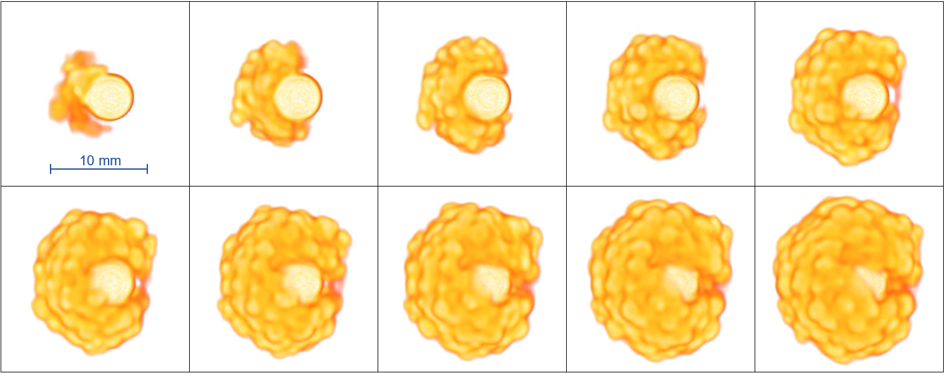Modeling of material injection processes into porous
Background
Vertebroplasty has become an important technique for stabilization of osteoporotic vertebral fractures and other weakening lesions such as angioma or metastatic tumors. However, this procedure presents a significant risk through cement leakage that can result in serious complications such as pulmonary embolism or compressions of nerve roots or the spinal cord. Simulations of the bone cement injection processes could predict injection rates, injection pressures, bone cement distribution within the vertebra and the probability of cement leakage, thus providing a valuable risk assessment tool. However, risk assessment can only be performed if realistic simulations of the entire vertebra are performed.
Goal
To collect experimental data by means of quasi-continuous CT scanning and to model material injection processes applied to vertebroplasty describing bone cement flow behavior and distribution, biomechanical behavior at the interface between bone cement and trabecular structure, and bone cement curing.
Results
A bone cement injector was developed and used in the proof-of-concept experimental phase of the project. Polyurethane foam samples with structure similar to trabecular bone were injected with gelatin containing contrast medium instead of fast-hardening bone cement. The force applied to the plunger of the syringe during CT scanning was recorded at 10 Hz. An animation of the 3D cement expansion was created from the recorded CT image data and will serve for parametrization and validation of the numerical models at University of Stuttgart.
Fund:
German Research Foundation (DFG), Special Research Area (SFB), ARI funding: EUR 100'000, Period: 2018-2021.
-
PublicationTrivedi Z, Bleiler C, Gehweiler D, Gueorguiev-Rüegg B, Ricken T, Wagner A, Röhrle O. Simulating vertebroplasty: A biomechanical challenge. Proc Appl Math Mech. 2020;20(1):e202000313 (conference paper GAMM 2020 virtual / oral) https://doi.org/10.1002/pamm.202000313
Trivedi Z, Gehweiler D, Wychowaniec JK, Ricken T, Gueorguiev B, Wagner A, Röhrle O. A continuum mechanical porous media model for vertebroplasty: Numerical simulations and experimental validation. Biomech Model Mechanobiol. 2023;epub May 12. https://doi.org/10.1007/s10237-023-01715-4
Trivedi Z, Gehweiler D, Wychowaniec JK, Ricken T, Gueorguiev B, Wagner A, Röhrle O. Analysing the bone cement flow in the injection apparatus during vertebroplasty. Proc Appl Math Mech. 2023;23(1): e202200295. https://doi.org/10.1002/pamm.202200295Trivedi Z, Wychowaniec JK, Gehweiler D, Sprecher CM, Boger A, Gueorguiev B, et al. Rheological Analysis and Evaluation of Measurement Techniques for Curing Poly(Methyl Methacrylate) Bone Cement in Vertebroplasty
ACS Biomater Sci Eng. 2024;10(7):4575-86.
https://doi.org/10.1021/acsbiomaterials.4c00417 -
Presentation
Trivedi Z, Gehweiler D, Wagner A, Gueorguiev B, Ricken T, Röhrle O. A porous media flow model for simulating flow of non-Newtoninan bone cement inside a deformable vertebra in the context of vertebroplasty. 2022 InterPore (oral)
Trivedi Z, Gehweiler D, Wychowaniec J, Wagner A, Gueorguiev B, Ricken T, Röhrle O. Simulating vertebroplasty using a continuum model based on the Theory of Porous Media and its validation. 2022 GAMM (oral)
Trivedi Z, Gehweiler D, Wychowaniec JK, Ricken T, Gueorguiev B, Wagner A, Röhrle O. Analysing the bone cement flow in the injection apparatus during vertebroplasty, 6 p. in: 2023 Proceedings in Applied Mathematics and Mechanics (GAMM 2022 / conference paper)
-
Partner
Röhrle O (Prof), University of Stuttgart, Germany
Wagner A, University of Stuttgart, Germany
Trivedi Z, University of Stuttgart, Germany


